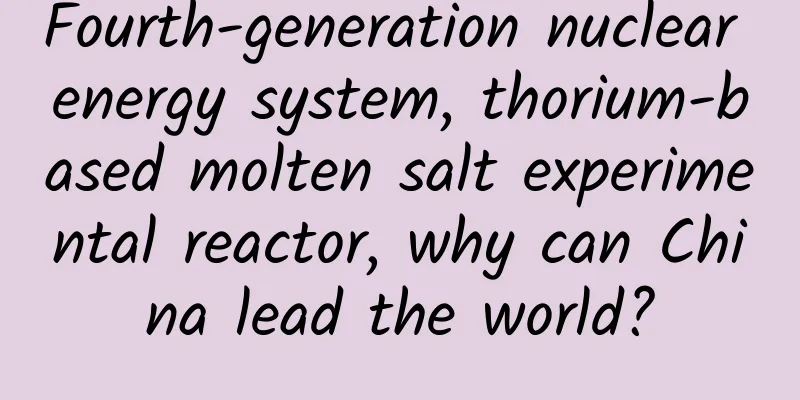Fourth-generation nuclear energy system, thorium-based molten salt experimental reactor, why can China lead the world?

|
Energy is an unavoidable topic in development, and a good energy source must meet at least two conditions, namely, cleanliness and efficiency. In this regard, nuclear energy is undoubtedly the best. Of course, nuclear energy is not perfect. Once a safety accident occurs, it may bring unimaginable consequences. In order to enhance the safety of nuclear energy use and further improve the efficiency of nuclear energy utilization, various countries are constantly updating their nuclear energy systems. The nuclear energy systems currently widely used in the world are already third-generation technologies, and are moving towards fourth-generation nuclear energy systems. What is the fourth-generation nuclear energy system? Compared with the third-generation nuclear energy technology, the fourth-generation technology can be regarded as a comprehensive improvement. The fourth-generation nuclear energy system is safer and more economical than previous ones. To be more specific, the fourth-generation nuclear energy system has the ability to prevent nuclear proliferation, and the waste generated is also greatly reduced. When it comes to the alternative options for the fourth-generation nuclear energy system, the Dukey molten salt reactor is undoubtedly the best choice at present. The United States also saw this as early as the 1940s and started research and development early, but in the end we got ahead of it. At the end of 2021, China's thorium-based molten salt experimental reactor started trial operation. This is the world's first thorium-based reactor, which indicates that my country has taken the lead in the world in the research and development of the fourth-generation nuclear energy system. What is the difference between a thorium-based molten salt reactor and a traditional nuclear power plant? We know that the core principle of nuclear power plants is to control nuclear fission and use the heat energy generated during the fission process to generate electricity. The raw material for the reaction is the familiar uranium 235. The fourth-generation thorium-based reactor no longer uses uranium, and the raw material for the reaction becomes thorium, which is of great significance to my country. The reserves of uranium 235 in nature are very small, accounting for only 0.7% of uranium ore. my country's uranium ore resources are originally scarce, which has made my country's uranium ore dependent on imports for a long time. Compared with uranium mines, the abundance of thorium in my country is much higher. The proven reserves are about 224,200 tons. If all of them are used in nuclear reactors, it can fully meet my country's energy needs for thousands or even tens of thousands of years. Compared with uranium 235, the advantage of thorium lies not only in its reserves, but also in its reaction products. The nuclear waste produced by traditional nuclear power plants contains a large amount of plutonium 239, which can be used to make nuclear weapons, which brings certain nuclear proliferation risks. The reaction products of thorium cannot be used to make nuclear weapons, so they are naturally safer. Another advantage of thorium-based molten salt reactors is that they are easy to promote. We all know that nuclear energy is clean and efficient, but why is it not built on a large scale? Because the construction of nuclear power plants is restricted by many factors. In addition to considering factors such as low population density and fewer geological disasters, there is another very important point when building a nuclear power plant, which is that it must be close to rivers and oceans. Why? Because there must be sufficient cooling water supply, which greatly limits the promotion of nuclear power plants. Thorium-based reactors are different. They only need a small amount of water to maintain operation, so there is no need for a constant supply of water. Without this condition, there are more places where nuclear power plants can be built. Even vast deserts with no people can become the construction sites of thorium-based nuclear power plants. Thorium-based reactors have so many advantages, and the United States was the first to start researching them, so why did China end up taking the lead? Although the United States developed it earlier, it was in a special historical period of the US-Soviet hegemony. There were many technical difficulties in the development of thorium-based molten salt reactors, such as the corrosion of molten salt on pipelines and the impact of irradiation on the mechanical properties of materials, which were difficult to solve at the time. Therefore, in the mid-1970s, this research was shelved. Now, these technical difficulties have been overcome by us. According to optimistic estimates, around 2030, my country's Duji molten salt reactor nuclear energy system may be able to achieve commercial application. For more information, please follow the official account: sunmonarch |
<<: Today I will tell you: What strange things have happened to the rose?
Recommend
Digital Human Lights the Main Torch of the Hangzhou Asian Games! The First in Asian Games History! How Did It Happen?
On September 23, 2023, at the opening ceremony of...
Empty State Interface Design for Mobile Apps
Actually, I still don't know when the Chinese...
2020, top ten marketing keywords!
Affected by the overall environment this year, al...
What is the “black technology” behind green steel production?
Editor's Note Millions of IPs create science ...
Is the world seen through cat’s eyes the same as the world seen through human eyes?
When we play with cats, what we like to look at m...
The "trial and error" journey of niche mobile phones
If you want to buy a mobile phone now, you will f...
Can JD.com’s smart home layout last long-term?
In the third week of March, JD.com, which occupie...
The more an ad looks like information, the more likely it is to be clicked? Please stop hurting your users.
There is a saying in current information flow ads...
E-paper, naked-eye 3D display...what will the future display look like?
Produced by: Science Popularization China Author:...
Is Samsung the resentful big wolf of TSMC?
Today, TSMC and Samsung, one is resentful, and th...
The Programming Story of Little Printf: Chapter 2
[[160955]] Chapter 2 of "Little Printf's...
Do the flavors of liquor really exist?
When it comes to liquor, there are many types. Fr...
How much is the price for Chizhou Property Mini Program agent? Chizhou Property Mini Program Agent Price Inquiry
Is it easy to be an agent of Chizhou Property Min...
Are probiotics really useful when taken in the stomach? Colonization antagonism is a big problem
You Wenjuan, Editorial Director of World Science,...
Apple announces it will stop signing iOS 14.6
After releasing iOS 14.7 last week, Apple has sto...









